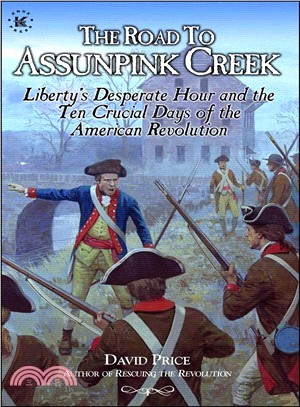Road to Assunpink Creek ― Liberty's Desperate Hour and the Ten Crucial Days of the American Revolution
商品資訊
ISBN13:9781948496070
出版社:Knox Pr
作者:David Price
出版日:2019/01/22
裝訂/頁數:平裝/192頁
規格:20.3cm*12.7cm*1cm (高/寬/厚)
商品簡介
作者簡介
相關商品
商品簡介
THE ROAD TO ASSUNPINK CREEK puts a spotlight on what may be the most unappreciated moment of a young nation’s revolutionary struggle when George Washington’s army narrowly escaped destruction to keep alive its fight for American independence.
Perhaps no military action in our country’s history is more paradoxical than the one on the road to Assunpink Creek, and at the bridge that crossed it, in the sense that its obscurity in the public mind and neglect by many historians is so disproportionate to its impact on the course of a conflict with global implications. The Battle of Assunpink Creek on January 2, 1777 was the second in a sequence of three victories by George Washington’s army during the “Ten Crucial Days” of the American Revolution—the period from December 25, 1776 through January 3, 1777. Those rapid-fire triumphs, the first significant successes by the Continental Army, reversed the momentum of the war when it appeared that America’s quest for independence from Great Britain was on the verge of total defeat.
When Washington’s army made its legendary Christmas night crossing of the Delaware River and captured the Hessian garrison in Trenton, the British and Hessian commanders sought a revenge that would destroy Washington’s dwindling army. Lt. General Charles Cornwallis was sent south with a force of over 7,000 men toward Trenton where Washington had set up a defensive position on the south bank of the Assunpink Creek. The ensuing engagement, also known as The Second Battle of Trenton, was in fact part of the Princeton Campaign. THE ROAD TO ASSUNPINK CREEK offers what many students of the period may regard as an unconventional and even contrarian approach. It does so by paying particular attention to what the author contends is clearly the most unappreciated event during this vital epoch and possibly of the entire war for independence — the military actions that occurred throughout the day and into the evening hours on January 2, 1777.
The January 2 battle has generally been given short shrift by historians relative to the other two American successes at the time. However, the events of that day provided the essential pivot point from the victory at the Battle of Trenton to the capstone win at Princeton by ensuring that the first Trenton engagement was not a “one-day wonder” but the beginning of a chain of events that changed the whole character of the contest. Had Washington been defeated at Assunpink Creek, his first victory at Trenton would have been a historical footnote, and there would have been no victory at Princeton. As it was, the events of January 2nd - that is, the fighting that occurred during the enemy’s advance from Princeton to Trenton and at the Assunpink itself—segued into the Americans’ overnight march around the enemy’s flank early on January 3rd, which led to the climactic victory of the “Ten Crucial Days” at the Battle of Princeton.
The engagement at Assunpink Creek was arguably the most critical moment of the “Ten Crucial Days” and the victory there perhaps the most undervalued of the entire war. Washington’s forces were at mortal peril of being trapped between two waterways with no way to escape if they were outflanked and pinned against the Delaware River. The American soldiers used words like “crisis” and “desperate” to describe their situation. Nathaniel Philbrick writes that by choosing to fight on this ground, “Washington had managed to . . . create what was, even if it is largely unappreciated today, the make-or-break moment of the War of Independence.”
With respect of the number of soldiers involved, the Battle of Assunpink Creek was the largest battle fought during these ten remarkable days. It was the only one in which the enemy had a numerical advantage, the only one in which Washington’s army had to fight both British and Hessian troops, the only one in which the crown’s forces were led by a British general—who also happened to be the most competent and energetic field commander in His Majesty’s Army, and the only one in which the geographic position of the Patriot forces put them at mortal peril of being trapped between two natural barriers—a creek on one side and a river on the other—with no means of evacuation if they were outflanked and driven back against the riverbank. January 2, 1777 also featured the longest battle of the “Ten Crucial Days” if one counts as a single encounter the resistance by Colonel Edward Hand’s men during their fighting withdrawal from Maidenhead to Trenton and the shoot-out at the creek immediately following their delaying action.Perhaps most importantly, this occasion marked the first time that the Continental Army beat back an attack by British troops during a significant battle.
Had the rebel army failed to stop the advance by the elite British and Hessian units at Assunpink Creek, the result would in all probability have been the destruction of that army and possibly with it the cause of American independence. And that scenario would almost certainly have entailed fatal consequences for Washington, either on the battlefield or at the end of a British rope.
In this deftly crafted narrative, the author explains how Washington’s desperate gamble paid off when the Continental Army fought a daylong running battle against a militarily superior foe and made a successful stand with its back to the Delaware River, avoiding the very real threat of total defeat and setting the stage for a dramatic counterattack against a surprised enemy. Price weaves what we know about these events into an exciting and unforgettable story and illuminates what most historians treat as an afterthought.
Praise forTHE ROAD TO ASSUNPINK CREE
“David Price has given us a clear, succinct, and gripping account of one of the pivotal moments of the Revolutionary War. This is an excellent portrayal of the battle and a reminder that there was much more to Washington's crossing of the Delaware than is usually remembered.” – Jack Kelly, author ofBand of Giants andThe Edge of Anarchy
"Drawing on the interpretations of noted historians of the ‘Ten Crucial Days’ that saved the American Revolution when its defeat seemed imminent, David Price tells the exciting story of those critical hours emphasizing the little-known, often neglected, but really very important battle at Trenton on January 2, 1777 that was a prelude to the Battle of Princeton the next day." – William L. Kidder, author of Ten Crucial Days: Washington’s Vision for Victory Unfolds
“Assembling the best scholarship on what has been called the ‘Ten Crucial Days,’ David Price has rightfully elevated the crucial importance of one of the least remembered battles of the Revolution—Assunpink Creek. The Road to Assunpink Creekis a finely crafted argument and illuminating book that shines light on many forgotten aspects of the battle, including the key role played by Edward Hand’s Pennsylvania riflemen. Price’s book is must reading for anyone interested in the Revolution.” – Patrick K. O’Donnell, bestselling author ofWashington’s Immortals: The Untold Story of an Elite Regiment Who Changed the Course of the Revolution
“The Battle of Assunpink Creek, or Second Trenton, bracketed by the more storied First Trenton and Princeton engagements, is typically under-chronicled by historians and unknown to laymen. David Price’s The Road to Assunpink Creekraises this overlooked but critical action to the status it rightfully deserves. Utilizing original sources and accounts by participants, Price deftly leads the reader through the latter part of the ‘Ten Crucial Days,’ offering a detailed explanation of both the battle and its ultimate importance. I certainly recommend this to all.” – Bill Welsch, President, American Revolution Round Table of Richmond and Co-founder of the Congress of ARRTs
“David Price’s concise analysis of a little-known yet significant Revolutionary War battle is both enlightening and entertaining.”– Glenn F. Williams, Ph.D.,author ofDunmore’s War: The Last Conflict of America’s Colonial Era andYear of the Hangman: George Washington’s Campaign Against the Iroquois
Perhaps no military action in our country’s history is more paradoxical than the one on the road to Assunpink Creek, and at the bridge that crossed it, in the sense that its obscurity in the public mind and neglect by many historians is so disproportionate to its impact on the course of a conflict with global implications. The Battle of Assunpink Creek on January 2, 1777 was the second in a sequence of three victories by George Washington’s army during the “Ten Crucial Days” of the American Revolution—the period from December 25, 1776 through January 3, 1777. Those rapid-fire triumphs, the first significant successes by the Continental Army, reversed the momentum of the war when it appeared that America’s quest for independence from Great Britain was on the verge of total defeat.
When Washington’s army made its legendary Christmas night crossing of the Delaware River and captured the Hessian garrison in Trenton, the British and Hessian commanders sought a revenge that would destroy Washington’s dwindling army. Lt. General Charles Cornwallis was sent south with a force of over 7,000 men toward Trenton where Washington had set up a defensive position on the south bank of the Assunpink Creek. The ensuing engagement, also known as The Second Battle of Trenton, was in fact part of the Princeton Campaign. THE ROAD TO ASSUNPINK CREEK offers what many students of the period may regard as an unconventional and even contrarian approach. It does so by paying particular attention to what the author contends is clearly the most unappreciated event during this vital epoch and possibly of the entire war for independence — the military actions that occurred throughout the day and into the evening hours on January 2, 1777.
The January 2 battle has generally been given short shrift by historians relative to the other two American successes at the time. However, the events of that day provided the essential pivot point from the victory at the Battle of Trenton to the capstone win at Princeton by ensuring that the first Trenton engagement was not a “one-day wonder” but the beginning of a chain of events that changed the whole character of the contest. Had Washington been defeated at Assunpink Creek, his first victory at Trenton would have been a historical footnote, and there would have been no victory at Princeton. As it was, the events of January 2nd - that is, the fighting that occurred during the enemy’s advance from Princeton to Trenton and at the Assunpink itself—segued into the Americans’ overnight march around the enemy’s flank early on January 3rd, which led to the climactic victory of the “Ten Crucial Days” at the Battle of Princeton.
The engagement at Assunpink Creek was arguably the most critical moment of the “Ten Crucial Days” and the victory there perhaps the most undervalued of the entire war. Washington’s forces were at mortal peril of being trapped between two waterways with no way to escape if they were outflanked and pinned against the Delaware River. The American soldiers used words like “crisis” and “desperate” to describe their situation. Nathaniel Philbrick writes that by choosing to fight on this ground, “Washington had managed to . . . create what was, even if it is largely unappreciated today, the make-or-break moment of the War of Independence.”
With respect of the number of soldiers involved, the Battle of Assunpink Creek was the largest battle fought during these ten remarkable days. It was the only one in which the enemy had a numerical advantage, the only one in which Washington’s army had to fight both British and Hessian troops, the only one in which the crown’s forces were led by a British general—who also happened to be the most competent and energetic field commander in His Majesty’s Army, and the only one in which the geographic position of the Patriot forces put them at mortal peril of being trapped between two natural barriers—a creek on one side and a river on the other—with no means of evacuation if they were outflanked and driven back against the riverbank. January 2, 1777 also featured the longest battle of the “Ten Crucial Days” if one counts as a single encounter the resistance by Colonel Edward Hand’s men during their fighting withdrawal from Maidenhead to Trenton and the shoot-out at the creek immediately following their delaying action.Perhaps most importantly, this occasion marked the first time that the Continental Army beat back an attack by British troops during a significant battle.
Had the rebel army failed to stop the advance by the elite British and Hessian units at Assunpink Creek, the result would in all probability have been the destruction of that army and possibly with it the cause of American independence. And that scenario would almost certainly have entailed fatal consequences for Washington, either on the battlefield or at the end of a British rope.
In this deftly crafted narrative, the author explains how Washington’s desperate gamble paid off when the Continental Army fought a daylong running battle against a militarily superior foe and made a successful stand with its back to the Delaware River, avoiding the very real threat of total defeat and setting the stage for a dramatic counterattack against a surprised enemy. Price weaves what we know about these events into an exciting and unforgettable story and illuminates what most historians treat as an afterthought.
Praise forTHE ROAD TO ASSUNPINK CREE
“David Price has given us a clear, succinct, and gripping account of one of the pivotal moments of the Revolutionary War. This is an excellent portrayal of the battle and a reminder that there was much more to Washington's crossing of the Delaware than is usually remembered.” – Jack Kelly, author ofBand of Giants andThe Edge of Anarchy
"Drawing on the interpretations of noted historians of the ‘Ten Crucial Days’ that saved the American Revolution when its defeat seemed imminent, David Price tells the exciting story of those critical hours emphasizing the little-known, often neglected, but really very important battle at Trenton on January 2, 1777 that was a prelude to the Battle of Princeton the next day." – William L. Kidder, author of Ten Crucial Days: Washington’s Vision for Victory Unfolds
“Assembling the best scholarship on what has been called the ‘Ten Crucial Days,’ David Price has rightfully elevated the crucial importance of one of the least remembered battles of the Revolution—Assunpink Creek. The Road to Assunpink Creekis a finely crafted argument and illuminating book that shines light on many forgotten aspects of the battle, including the key role played by Edward Hand’s Pennsylvania riflemen. Price’s book is must reading for anyone interested in the Revolution.” – Patrick K. O’Donnell, bestselling author ofWashington’s Immortals: The Untold Story of an Elite Regiment Who Changed the Course of the Revolution
“The Battle of Assunpink Creek, or Second Trenton, bracketed by the more storied First Trenton and Princeton engagements, is typically under-chronicled by historians and unknown to laymen. David Price’s The Road to Assunpink Creekraises this overlooked but critical action to the status it rightfully deserves. Utilizing original sources and accounts by participants, Price deftly leads the reader through the latter part of the ‘Ten Crucial Days,’ offering a detailed explanation of both the battle and its ultimate importance. I certainly recommend this to all.” – Bill Welsch, President, American Revolution Round Table of Richmond and Co-founder of the Congress of ARRTs
“David Price’s concise analysis of a little-known yet significant Revolutionary War battle is both enlightening and entertaining.”– Glenn F. Williams, Ph.D.,author ofDunmore’s War: The Last Conflict of America’s Colonial Era andYear of the Hangman: George Washington’s Campaign Against the Iroquois
作者簡介
David Price is a historical interpreter at Washington Crossing Historic Park, Pennsylvania and the author of Rescuing the Revolution: Unsung Patriot Heroes and the Ten Crucial Days of America’s War for Independence (Knox Press, 2016). Under the auspices of the Friends of Washington Crossing Park, he conducts guided interpretive tours at this Registered National Historic Landmark and site of the Continental Army's crossing of the Delaware River in 1776, focusing on the “Ten Crucial Days” of the American Revolution and other historical aspects of the park. David is also an authorized tour guide at Princeton Battlefield State Park in New Jersey. He holds degrees in political science from Drew University and Rutgers University—New Brunswick, and was a nonpartisan research analyst with the Office of Legislative Services of the New Jersey Legislature for 31 years. (His office in the State House Annex was barely more than a long stone’s throw from the Assunpink Creek.) He is a member of various national and regional organizations relating to the American Revolution. David lives in Lawrence Township, NJ (known as Maidenhead at the time of the Revolution).
主題書展
更多
主題書展
更多書展今日66折
您曾經瀏覽過的商品
購物須知
外文書商品之書封,為出版社提供之樣本。實際出貨商品,以出版社所提供之現有版本為主。部份書籍,因出版社供應狀況特殊,匯率將依實際狀況做調整。
無庫存之商品,在您完成訂單程序之後,將以空運的方式為你下單調貨。為了縮短等待的時間,建議您將外文書與其他商品分開下單,以獲得最快的取貨速度,平均調貨時間為1~2個月。
為了保護您的權益,「三民網路書店」提供會員七日商品鑑賞期(收到商品為起始日)。
若要辦理退貨,請在商品鑑賞期內寄回,且商品必須是全新狀態與完整包裝(商品、附件、發票、隨貨贈品等)否則恕不接受退貨。
























